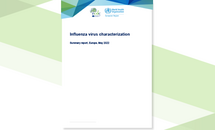Influenza virus characterisation - Summary Europe, July 2020
ECDC’s influenza virus characterisation reports are published periodically and give an overview of circulating influenza viruses. They provide details on the current vaccine strains, summarise the development of the viruses since the last report, and closely follow the main developments for the ongoing influenza season. Virus characterisation reports are primarily intended for influenza virologists and epidemiologists.
Executive Summary
This is the ninth report for the 2019-20 influenza season. As of week 30/2020, 164 887 influenza detections had been reported across the WHO European Region; 73% type A viruses, with A(H1N1)pdm09 prevailing over A(H3N2), and 27% type B viruses, with 4 479 (98%) of 4 568 ascribed to a B/Victoria lineage.
Since the June 2020 characterisation report report, three shipments of influenza positive specimens from EU/EEA countries have been received at the London WHO Collaborating Centre, the Francis Crick Worldwide Influenza Centre (WIC). In total (since wee k 40/2019) 2019), 1 661 virus specimens have been received, with collection dates after 31 August 2019.
Of the 4 9 A(H1N1)pdm09 viruses from EU/EEA countries characterised antigenically since the June report, 36 were well recognised by antisera raised against the 2019 20 vaccine virus, A/Brisbane/02/2018. The 13 viruses showing poor reactivity generally carried amino acid substitutions (notably N156K) in the HA1 150 loop region. The 468 EU/EEA test viruses with collec tion dates from week 40/2019 genetically characterised at the WIC have fallen within subclades of clade 6B.1A: 425 6B.1A5A, 30 6B.1A5B, 1 6B.1A6 and 12 6B.1A7.
The majority (39) of the 68 A(H3N2) viruses from EU/EEA countries characterised antigenically in July were clade 3C.3a and were well recognised by antiserum raised against egg propagated A/Kansas/14/2017, the current vaccine virus. Globally approximately equal proportions of clade 3C.3a and subgroups 3C.2a1b+T131K and 3C.2a1b+T135K viruses have bee n detected , but for viruses detected since 1 February 2020, subgroups 3c.2a1b+T135KA/B have prevailed in the USA while those of clade 3C.3a and subgroup 3C.2a1b+T131K have dominate d in Europe. In total, 500 viruses from EU/EEA countries have been characterised genetically at the WIC: 2 82 were clade 3C.3a, 1 37 were 3C.2a1b+T131K, 61 were 3C.2a1b+T135K A and 20 were 3C.2a1b+T135K B.
Thirty two B/Victoria lineage viruses from EU/EEA countries were antigenically characterised in July, all were subclade 1A(Δ3)B. Four viruses were not recognised well by antiserum raised against B/Washington/02/2019, the vaccine virus for the 2020 2021 northern hemisphere influenza season. Poor recognition was associated with HA1 a mino acid substitutions of either N126K or T155A . In total, 306 EU/EEA viruses have been characterised genetically at the WIC: 2 90 were sub clade 1A(Δ3)B and 1 6 were subclade 1A(Δ2).
A single B/Yamagata lineage virus from France, with a collection date in February 2020, was antigenically characterised in July. As for all recently circulating B/Yamagata lineage viruses a ll eight EU/EEA viruses characterised genetically at the WIC since week 40/2019 belong to genetic clade 3 and contain at least two HA amino acid substitutions (HA1 L172Q and M251V) compared to B/Phuket/3073/2013, the antigenic effects of which have been minimal as assessed in earlier reports.
Download







